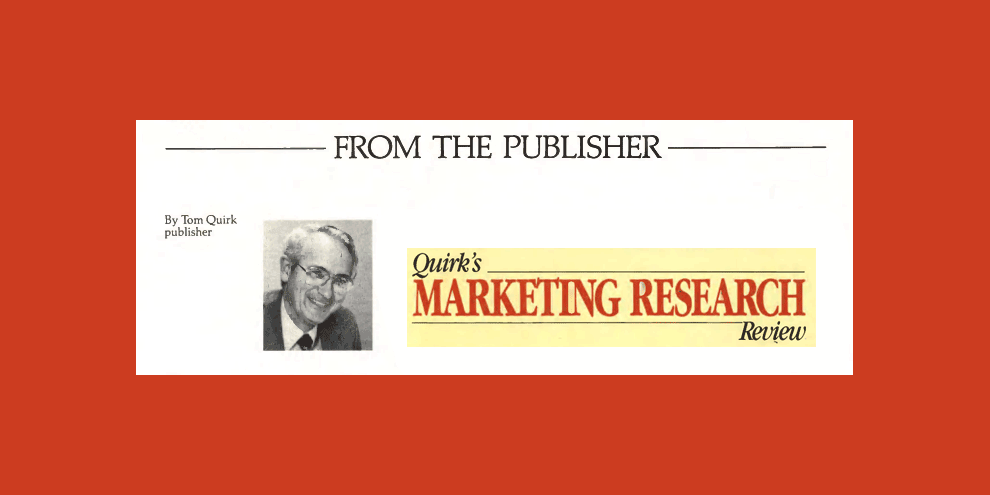Focus group interviews have grown in importance and use for obtaining qualitative information among business-to-business researchers. However, for a variety of reasons, one-on-one qualitative interviews continue to be the most frequently used method to obtain this type of information.
One of the more successful uses of this technique of which I am aware involved a health products company. This company had been a leader in its field providing excellent products and having a strong commitment to sales support. It not only had the largest sales force but the company was also very liberal in allocating monies for their salesmen to use for various merchandising programs with their distributors.
Profit margins were drastically reduced as the major products within this market matured and lost patent protection. The company's plan to reduce funds for merchandising programs met with fierce resistance from the sales force who claimed these programs were a major factor in decision-making.
The marketing research department was assigned numerous tasks: Studying the use of merchandising programs within the industry; determine their distributors' attitude toward merchandising programs, and find out what the competition was doing in the way of merchandising products. They were also supposed to determine how the distributors felt about the merchandising programs they were sponsoring as well as the possible effect on sales if these programs were scaled back.
Action plan
The first step was to develop a plan of action. It was determined that the information could only be obtained through face-to-face meetings with the individuals at the distributor level who were responsible for implementing these merchandising programs. Twenty-seven companies were targeted for interviewing because they represented almost 70% of the product sales and 85% of the merchandising expenditures. The use of focus groups was considered but discarded because the individuals were not in close proximity to one another and because some of the questions would require quantitative answers which would only be available in the files of the respondents' offices.
The research personnel knew that the key to a successful project would be the individual selected to conduct the interviewing. The person would have to be an excellent interviewer and able to arrange meeting times with hard-to-reach individuals such as marketing vice presidents, directors of marketing and sales managers.
After a thorough search, the selection process finally settled on an individual within a research firm who had extensive interviewing experience. This person had previously been a research director for a leading publication serving this market and therefore his name was well-known to targeted interviewees. These two factors were the major reasons why he was selected.
The interviewer and the client met to determine the next steps. The client indicated the specific information needs, the targeted audience and the overall timetable. The interviewer then developed a questionnaire outline, provided more specific dates for expected percentage of interviewing completes and interim verbal reports.
The importance of interviewer selection became apparent not only because of the information obtained but also because the interviewer was able to arrange interviews with every individual who had been targeted. Not a single person was missed andmost gave him a full hour to conduct the session.
Industry knowledge
The interviewer's knowledge of the industry made it possible to act properly to the industry "buzz words." Awareness of the competitive companies and their product lines also ensured a smooth flow of the interview. Because of the interviewer's reputation in the field and knowledge of the subject, the interviewees provided detailed information regarding the merchandising programs available, their attitude toward and degree of participation in each, and their feelings concerning the client's merchandising programs and philosophy.
Almost without exception the marketing and sales directors believed the merchandising programs were overdone and not accomplishing the purposes for which they had originally been instituted. Some companies had excess paperwork requirements before reimbursing the distributors while others required little, if any, verification. Few of the programs could be justified, if a requirement existed, to prove that the monies resulted in increased business.
The client was the biggest spender among the companies in this field and it received the most criticism. Distributors stated that the client's profit margin was excessive if it could distribute as much money as it did without setting up goals. They did not equate this spending with product support as the client had intended. The distributors saw it as a crutch which the sales force used to ingratiate themselves and the distributors were somewhat envious because their own profit margins did not allow for this type of spending.
The results of this study gave the client an opportunity to make drastic changes in its marketing programs. The merchandising programs were severely reduced and controls were instituted to insure that specific objectives were established before any merchandising program was started.
At the conclusion of each program a report was issued with very specific information provided as to the impact of the program and whether the goals had been met. Sales personnel were held accountable.
The first year's savings in the reduced merchandising programs were 10 times the cost of the study. A later study showed that the company's image among the targeted customer group had improved during this period. It had turned out to be an unusual case where spending too much money in merchandising had created a negative effect.
In this particular instance, the importance of correct interviewer selection cannot be overemphasized. It is unlikely that someone who had been unfamiliar with this market and who did not have contacts within the industry would have been successful in obtaining either the appointments or the time to collect the necessary information. Successful research requires the optimal use of an individual's time anc talent. This marketing research department's careful screening process made the best use of the right person for the project.
